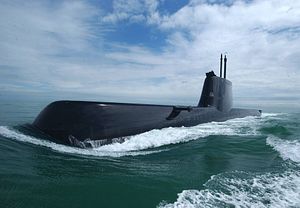South Korean shipbuilder Hyundai Heavy Industries (HHI) has launched the ninth Son Won II-class (Type 214) diesel-electric air-independent propulsion (AIP) attack submarine in a ceremony held at the HHI shipyard in Ulsan on September 7, the Republic of Korea (ROK) Navy reports.
Senior ROK Navy officials emphasized the precision strike capabilities of the new submarine during the the launch ceremony at the HHI shipyard in Ulsan, a port city in southeastern South Korea.
“It’s a national strategic dagger capable of precisely striking not only the enemy’s ships and submarines but also ground targets deep inland,” Admiral Um Hyun-seong, the ROK Navy chief of staff, said in his remarks, according to Yonhap news agency.
The 1,800-ton Sin Dol-Seok, launched in 2014, is the sixth Son Won II-class (aka KSS-2) launched by HHI; Daewoo Shipbuilding & Marine Engineering (DSME) manufactured the other three submarines of the class. It is the final submarine of its class launched under the ROK Navy’s Son Won II-class acquisition program. However, as I explained previously, this is far from the end for South Korea’s overall submarine construction:
The recent launch is part of a three-phased naval construction program to build up the ROKN attack submarine force. South Korea currently operates a fleet of nine 1,200-ton Chang Bogo-class diesel-electric attack submarines – a variant of the German Type 209 boat. Under the first phase, the ROKN is planning to upgrade all nine Chang Bogo-class submarines with air-independent propulsion and flank-array sonars over the next few years.
The nine Son Won II-class vessels are part of the second phase of the ROKN’s so-called Korean Attack Submarine program. The third and final phase (and also the most ambitious part of the project) will be the construction of nine indigenously produced 3,000-ton diesel-electric attack submarines – designated KSS-III – equipped with air-independent propulsion and multiple vertical launch tubes from which Hyunmoo-3C cruise missiles with a range of up to 1,500 kilometers can be fired.
The Son Won II-class is a license-built variant of the Type 214 submarine build by Howaldtswerke-Deutsche Werft in Germany. It is expected to be enter service with the ROK Navy in 2019. The submarine, measuring 65 meters (213 feet) in length and seven meters (22 feet) wide, it is capable of reaching a top surface speed of 12 knots and up to 20 knots when submerged with its electric motor.
“With its air-independent propulsion system, built around Siemens polymer electrolytic membrane fuel cells, the submarine can stay submerged for up to two weeks and can dive up to 400 meters (1,312 feet) deep,” I reported elsewhere. The submarine can be armed with long-range submarine-to-ground cruise missiles, anti-ship cruise missiles, heavyweight anti-ship torpedoes, and naval mines.
South Korea has been working on a new submarine-launched ballistic missile (SLBM) for its next class( KSS-III) of diesel-electric attack submarines. The missile will likely be a variant of the Hyunmoo-2B or the Hyunmoo-2A, as I reported previously.
In July, the ROK Navy took delivery of the sixth Son Won II-class, the Yu Gwan-sun. The ROK Navy is slated to operate 18 diesel-electric attack subs by 2019.































